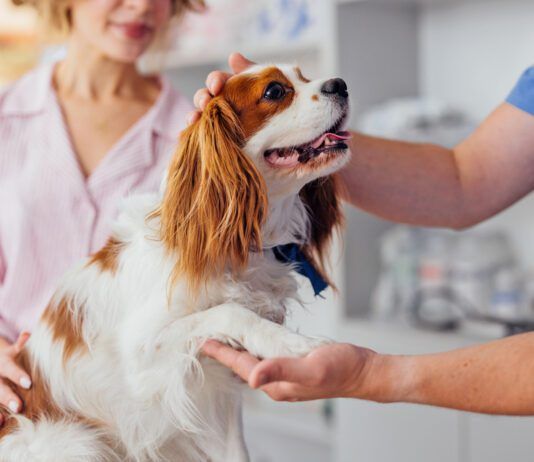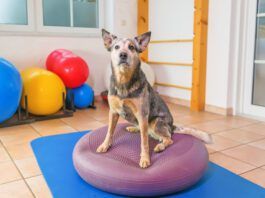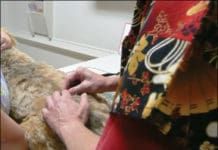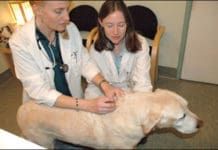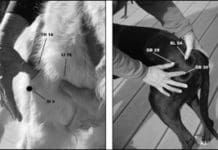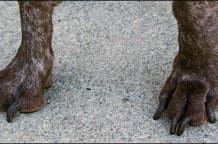Finding Your Dog a Playmate
Otto is such a lucky dog: he's found a best friend. Lena is also a young dog (about a year old, to Otto's two years), about his size, and she loves to play all of his favorite games, including Chase me
Dogs Riding Safely and Calmly in Cars
Contrary to the advice I offer to clients and WDJ readers, I admit that I'm sometimes careless about taking my dogs in the car with me. I don't always use crates and seatbelts on short trips to town, although I always do on longer travels. Just recently, however, my husband and I loaded up all five of our dogs for their annual well-pet visit to a veterinarian, and I did take the precaution of crating everyone rather than risk canine chaos on the highway. Other than Bonnie's panting, it was an experience in car-ride serenity, and I vowed to crate everyone, always, on future rides. Granted, my dogs aren't the worst in the car. They don't sit in my lap, leap over seats, get into fights, hang out the windows, do laps around the back of the van, or bark at everything outside the car. Other than Bonnie, who pants a lot and sometimes Even so, they're safer in crates. Loose, they are a distraction, which decreases my driving safety. Not as bad as texting, but still!
Acupuncture For Dogs With Cancer
without any hesitation
Training Your Dog to Comfortably Wear a Muzzle
Long thought to be a sign of a bad dog
Selecting The Best Family Dog and Preparing Him for Children
not just tolerate them. And if she shows signs of discomfort (such as looking away or moving away from children)
Finding the Right Rawhide Chew For Your Dog
but they are anything but equal in terms of safety
Pet Insurance
Last year my Border Terrier, Dash, received advanced canine dental treatments to the tune of more than $2,500 (described in "Improve Your Dental Acuity," Whole Dog Journal July 2008). Her root canal, surgical extraction, and periodontal treatments were necessary to improve her health, but they certainly stretched my checkbook until I could hear the twang! Fortunately, I was able to afford these procedures. But, who knows what could happen next to either of my two dogs, and how much it might cost? And how can I be prepared to provide a lifetime of high quality healthcare when my next puppy comes along? For the first time I am seriously considering the benefits of pet health insurance for my dogs (both seniors), and, especially, for any young dog who joins my family in the future.Advances in veterinary science have led to the availability of high-tech wellness care, diagnostic testing, treatments, and surgical procedures. Cancer care, MRIs, pacemakers, joint replacements, and, yes, advanced dental care are increasingly common. Many private veterinary practices now offer high-tech procedures previously offered only at regional, specialty referral clinics. The American Pet Products Association (APPA) estimates that, in 2008, dog owners spent more than $10 billion on veterinary care. The APPA's 2007/2008 national pet survey reported that the average "routine veterinary visit" for a dog cost more than $200, and the average "surgical vet visit" cost more than $450. Advanced, high-tech treatments cost much more. If you want to provide your dog with high quality healthcare throughout his life, pet health insurance deserves a serious look. And since you can't buy health insurance for your dog when you really need it most, like in an emergency, or when a pre-existing condition erupts into a critical situation, now is the best time to look into health insurance that could save you hundreds or even thousands of dollars.
Canine Acupressure Techniques to Promote Healing
located in a depression just in front of the greater trochanter (large bony protuberance) of the femur; BL 54
Train Your Dog to Behave During Grooming
Two months ago, I read a news story about a dog owner in Minnesota who had shared her home and her life with her 10-year-old Great Pyrenees for eight years. On December 30, 2008, the dog attacked his owner as she was trying to trim his nails, sending her to the hospital for multiple bite wounds to her arms. The news report on the incident stated, “[The dog owner] was able to reach another room and closed the door, keeping the dog out.” The owner in this sad story was treated and released from the hospital the same day. The dog is now dead – euthanized at the veterinary hospital for safety reasons, at the owner’s request.Nail-trimming should not be a matter of life and death. Nor should any other routine grooming procedure. If a dog objects strongly to any sort of physical contact or restraint that may occur in the process of ordinary care, a smart, responsible owner needs to take immediate steps to overcome his objections in a positive, nonaversive manner. Fortunately, this process (described in detail below) is not difficult (or dangerous!) to do – but it does take a serious commitment of time.
Your Children Should Help Train the Dog
Unless you've been living in a cave for the past year, you know that Malia and Sasha Obama will soon be getting their very first dog. Every year, children all over the world experience the joy of holding a dog or puppy in their arms for the very first time. We trust that the Obamas will select wisely, and make the right training choices for the newest member of the First Family. If a new dog is in your future, we hope that you'll do the same.For many kids, getting a family dog is one of the happiest experiences imaginable. However, disturbing dog bite statistics from the Centers for Disease Control (CDC) suggest that all is not well in the kid-dog kingdom. According to the CDC, each year, 800,000 Americans seek medical attention for dog bites. Half of these are children. Your best insurance against your family being part of these statistics is a puppy-raising program that incorporates proper management and supervision and tons of carefully orchestrated, positive social experiences for your new dog. (For more about how to carry out an ideal socialization program, see The Social Scene
Cognitive Dysfunction Syndrome in Senior Dogs
Each of us has, at some point, wandered into a room and realized that we've forgotten why we've gone there. When that happens, chances are we are momentarily perturbed with ourselves, but typically we chalk it up to too much on the brain, remember why we're there, then move on. Should our dogs wander in the same fashion, it could well be a sign of cognitive dysfunction syndrome (CDS), a condition quite similar to Alzheimer's in humans. CDS happens when the aging process affects brain pathology, resulting in behavioral changes, including cognitive decline (memory and learning).
If Your Dog Goes Missing
For some reason the blinking red light on my phone that signals “message waiting” always seems ominous to me. Last Thursday, my wariness was reinforced: my friend Cindy had left a frantic message. Her dog was lost. “Hattie’s missing!” I could hear the panic in her voice. “I was walking her at Antietam Battlefield last night, the leash came off her collar, and she took off after a deer!” Bad news. In many parts of the country, dogs who chase wildlife or livestock can be shot. There was more bad news as Cindy’s message continued. “I have to leave town today for a work-related retreat. I have people looking for her, but if there’s anything you can do?” I called Cindy back immediately. She had already placed a “lost dog” ad in the paper for her 18-month-old, wheaten-colored, Irish Wolfhound-mix. She had put up posters in the area where Hattie was lost, as well as on the five-mile route between the park and her house in Sharpsburg. She had notified the only shelter in the county that handles stray dogs. She left one of her sweatshirts in the spot where Hattie went missing. And she had people who knew Hattie well - staff from the doggie daycare facility she visited regularly - looking for her. There wasn’t much more I could do. I gave her contact information for a person in Maryland who has a dog trained to find missing pets, and suggested setting a humane dog trap. And praying.


